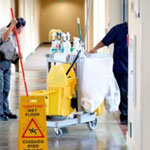
Blog
Washroom Cleaning During COVID
February 22, 2021

We are all stepping up our cleaning game to protect our friends, families, clients, and colleagues during the coronavirus pandemic. When it comes to cleaning and disinfecting washrooms during COVID, we want to take special care to ensure surfaces and objects are thoroughly cleaned and disinfected because the COVID-19 virus may live on surfaces for hours or even days. Frequently touched washroom surfaces including doorknobs, light switches, cabinet handles, faucet handles, toilet flush levers, and countertops are the most likely to be contaminated, but we also want to be mindful of other washroom surfaces including floors and toilets. So, what do you need to know about washroom cleaning during COVID? Read on.
Cleaning and Disinfecting
Cleaning and disinfecting are not the same. Cleaners such as soap and detergent can reduce the number of germs on surfaces but do not always completely kill all germs. Cleaning is certainly important for reducing the risk of spreading the virus that causes COVID-19, but disinfection is another step in the process. Disinfectant products kill all germs on surfaces. Health Canada approves a variety of disinfectants for hard surfaces that are known to kill the coronavirus; always look for a product with a drug identification number that is approved by Health Canada. If you cannot find an approved disinfectant, you can also create your own solution by diluting bleach.
Chlorine bleach is a very strong disinfectant that will kill bacteria, fungus, and viruses, but it can also be harmful to your skin, eyes, and lungs – so you must take care to handle it safely. Never mix bleach with other cleaning products and always dilute bleach before cleaning surfaces. Health Canada recommends that you only dilute bleach as needed; in other words, do not mix up a large container of diluted bleach that is stored for future use as you want to reduce the risk that the diluted bleach is mistaken for another product and used accidentally for other purposes. When diluting bleach for disinfecting frequently-touched surfaces, follow the label instructions. Bleach that is 5% sodium hypochlorite can be diluted by pouring bleach into water (and never by pouring water into bleach) with concentrations as follows:
- Mix 1 teaspoon (5ml) of bleach with 1 cup (250 ml) water, or
- 4 teaspoons (20 ml) of bleach with 4 cups (1 litre) of water.
Also, it cannot be stated too strongly (or too often) that bleach should never be mixed with other cleaning products or chemicals. Additionally, bleach is not safe for cleaning skin. It is always important to wear goggles and a mask when diluting bleach and to do so in a well-ventilated area.
Finally, you want to create a cleaning and disinfecting process that begins with cleaning surfaces before disinfecting. After disinfecting, wash your hands with soap and water for at least 20 seconds or use an alcohol-based hand sanitizer that contains at least 60% alcohol.

